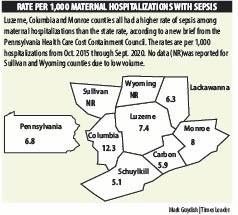Click here to subscribe today or Login.
Luzerne County and two neighboring counties have higher rates of potentially serious sepsis among maternal hospitalizations than the state rate, according to a new brief released by the Pennsylvania Health Care Cost Containment Council.
The council reviewed data from Oct. 2015 through Sept. 2020, looking at the number of woman admitted to hospitals for delivery or other pregnancy-related conditions who also had a diagnosis of sepsis, a system-wide inflammatory response to infection.
Sepsis can lead to acute organ dysfunction and failure, and can be fatal.
Statewide there were 698,576 maternal hospitalizations during that time. Sepsis was present in 4,794 of those cases, making about 6.9 cases per 1,000 with sepsis.
By comparison, Luzerne County had 7.4 sepsis cases per 1,000 maternal hospitalizations, while the rate in Monroe County was 8 per 1,000 and the rate in Columbia County was 12.3 per 1,000. The Columbia County rate was the highest among the state’s 67 counties, more than in Philadelphia County, where the rate was 11.5 per 1,000.
Philadelphia often has some of the poorest health outcomes in the Council’s reports.
The Council did not report data for Sullivan and Wyoming counties because the volume of cases was low. The remaining neighboring counties — Lackawanna, Carbon and Schuylkill — were below the state rate.
In a media release, the council noted the brief was being released in conjunction with national Women’s Health Week, calling sepsis “an important maternal health issue.”
Statewide, sepsis is more prevalent, proportionally, among minorities and low-income families:
• Black, non-Hispanic patients comprised 16.2% of maternal stays without sepsis, but they comprised 25.9% of maternal stays with sepsis.
• Hispanic patients comprised 8.5% of maternal stays without sepsis, but they comprised 13.3% of maternal stays with sepsis.
• Patients living in the highest poverty areas (where 25% or more of the population lives in poverty) comprised 13.7% of maternal stays without sepsis, but they comprised 23.6% of maternal stays with sepsis.
The data also showed younger people are more likely to have sepsis:
• Sepsis was more likely among patients ages 12-17 and 18-24.
• Patients 12-17 years comprised 1.2% of maternal stays without sepsis, but they comprised 2.6% of maternal stays with sepsis.
• Patients 18-24 years comprised 21.5% of maternal stays without sepsis, but they comprised 30.9% of maternal stays with sepsis.
Reach Mark Guydish at 570-991-6112 or on Twitter @TLMarkGuydish





